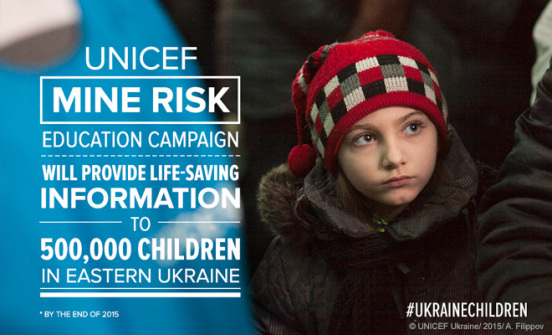KYIV/GENEVA — At least 109 children are reported to have been injured and 42 killed by land mines and unexploded ordnance in the Donetsk and Luhansk regions of eastern Ukraine since March last year, UNICEF on 31 March 2015 said.
The government-reported figures may not reflect the actual number of child casualties from land mines and unexploded ordnance in eastern Ukraine.*
“The number of children killed and maimed by mines and unexploded ordnance would be significantly higher if we include non-government controlled areas,” said Marie-Pierre Poirier, UNICEF Regional Director for Central and Eastern Europe and the Commonwealth of the Independent States, who recently returned from visiting the eastern regions of Ukraine. “Lack of access to these areas is a real challenge for humanitarian actors on the ground.”
After a year of conflict, many communities in eastern Ukraine have been exposed to extreme levels of violence, including through the use of heavy weapons – the remnants of which have been left behind in devastated towns and villages.
The State Emergency Service of Ukraine is actively clearing government-controlled areas from mines and unexploded ordnance in Donetsk and Luhansk oblasts.
More than 33,717 items of ordnance have been located and removed thus far. Yet displaced families returning to communities formerly under conflict are still at great risk from the highly hazardous materials that have yet to be cleared.
Children in particular are at risk from unexploded ordnance and landmines which may be brightly coloured and small enough to pick up or kick around. Children could be drawn to such items, mistaking them for toys or objects of value, which can result in tragedy.
UNICEF and its partners have launched a mine-risk education campaign in crisis-affected areas of Ukraine to provide 500,000 children and their families with lifesaving information about the risks posed by landmines and explosives.
The campaign includes risk educational messages in print, video and digital formats as well as the training of 100 teachers and school psychologists on mine-risk awareness.
© UNICEF/NYHQ2014-3500/Volpi | Natalia and her little brother, Ivan, stand in the bomb shelter where they and their mother have sought refuge as a result of the ongoing conflict, in the city of Donetsk in Ukraine.“Until now, there has been very little community awareness and understanding of the dangers posed by mines and explosives used in the conflict,” said Poirier.
“That is why we are working with our partners to strengthen families’ knowledge of the hazardous munitions remaining in many communities that have seen fighting – so that children and their parents know what to watch out for and how they can stay safe.”
At least 5 million people in Ukraine are affected by the crisis, including 1.7 million children, while more than 1.1 million people have been internally displaced in-country because of ongoing violence. UNICEF is appealing for US$55.8 million to meet the urgent humanitarian needs of children and families.
With the 4 April International Day of Mine Awareness and Assistance in Mine Action just days away, the situation in Ukraine is a grave reminder that despite global progress in de-mining, children and communities continue to fall victim to mines and explosive remnants of war.
In 2013, the last year for which figures have been compiled, 3,308 casualties from mines and explosive remnants of war were reported globally. This included 1,112 children –333 of whom died as a result of their injuries. Child casualties were reported across a range of countries under conflict including Afghanistan, South Sudan and Yemen.
The Mine Ban Treaty, enacted in 1999, has now been ratified by more than three-quarters of the world’s nations, including Ukraine. It prohibits the production, stockpiling and use of antipersonnel landmines. Though the treaty has reduced the overall casualties, land mines still kill or maim thousands of people every year. (*Source: UNICEF).
Multimedia assets can be downloaded from: http://uni.cf/1GHuyfW
Read also:
‘Ukraine Crisis Taking Heaviest Toll on Women, Children and Elderly’
Over a Million May Already Be Displaced by Eastern Ukraine Violence – UN
Ukraine – Truce or Trojan Horse: Retreat, Re-Armament and Relaunch
‘Germany unhappy with the way NATO summit has gone over Russia and Ukraine’
The Return of George Orwell and Big Brother’s War on Palestine, Ukraine and the Truth
“Washington’s War Crimes Spread from Africa and the Middle East to Ukraine”
2015 Human Wrongs Watch







